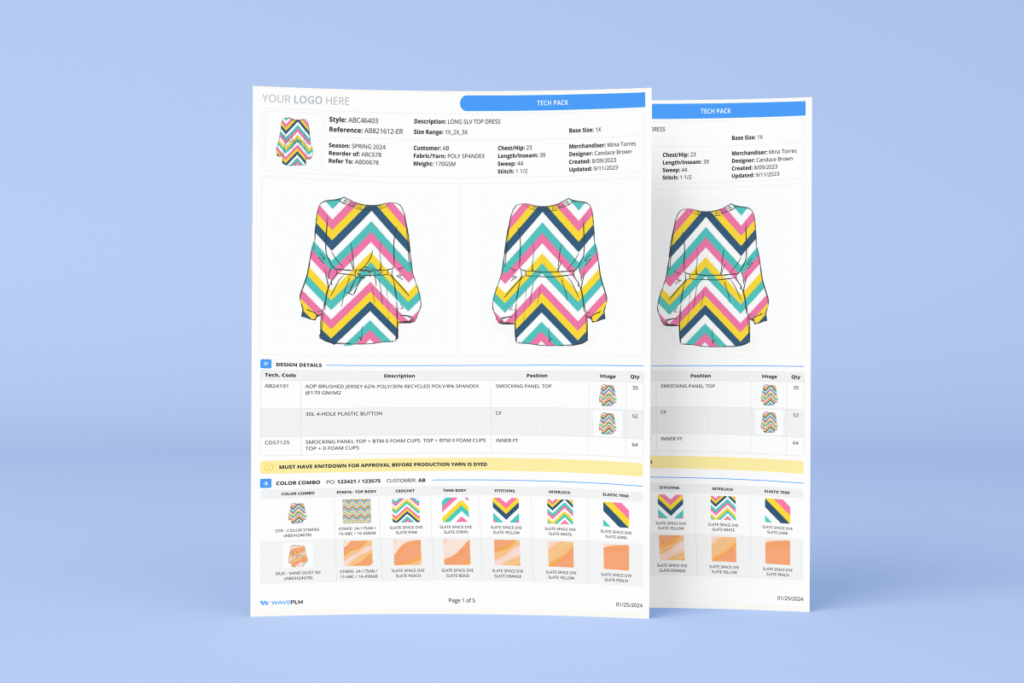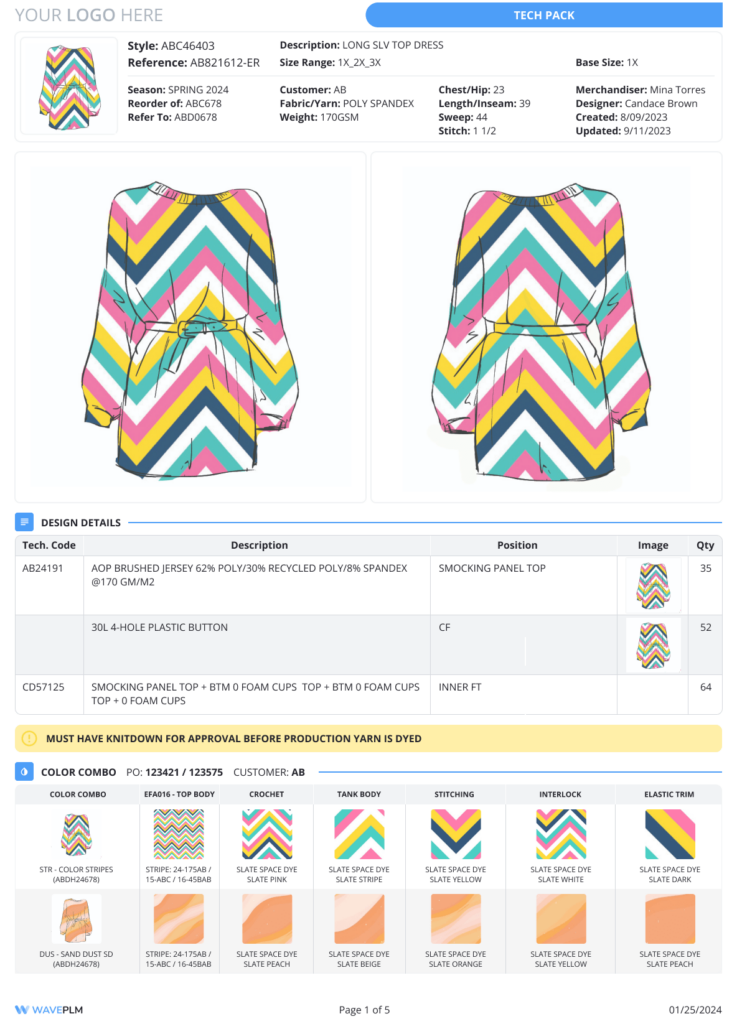
In product development, where ideas transition into tangible realities, the Tech Pack Template emerges as a cornerstone document. Its significance lies not only in its role as a blueprint but also as a compass guiding the journey from concept to creation. Crafting a flawless, professional tech pack transcends mere documentation; it demands an amalgamation of precision, clarity, and artistry.
In the previous article, we talked about what a tech pack is and why you need this instrument in your fashion business. This article aims to elucidate the components comprising a complete tech pack, provide guidance on optimizing its clarity and comprehensibility and give you an example of a tech pack template generated by Wave PLM.
Understanding the Anatomy of a Tech Pack Template:
A tech pack is more than a compilation of specifications; it is a comprehensive dossier encapsulating every facet of a product’s journey. At its essence, a well-structured tech spec pack template should encompass:
1. Cover Page:
The cover page is the first thing anyone will see when they open your tech pack. It should include essential information such as the product name, style number, season or collection name, and any other identifiers relevant to your project. This page sets the tone for the entire document and should be visually appealing while clearly conveying important details.
2. Technical Sketches:
Technical sketches are detailed drawings of your product from various angles. These sketches should accurately represent the design, dimensions, and proportions of the item. Include close-up views of intricate details and any relevant annotations to ensure clarity. These sketches serve as a visual reference for manufacturers, pattern makers, and other stakeholders involved in the production process.
3. Bill of Materials (BOM):
The bill of materials (BOM) is a comprehensive list of all the materials needed to create your product. This includes fabrics, trims, hardware, and any other components required for assembly. Each item in the BOM should be clearly listed along with its corresponding quantity, description, and specifications such as color, size, and material composition. Providing accurate and detailed information in the BOM is essential for sourcing the right materials and estimating production costs.
4. Measurements:
Accurate measurements are crucial for achieving the desired fit and proportions of your product. Include detailed size charts and measurement specifications for each size in your range. For example, this may involve providing flat measurements, body measurements, or both, depending on the garment type. Clear instructions on how and where to take measurements ensure consistency across samples and production runs.
5. Construction Details:
The construction details section outlines the assembly process for your product. This includes information on stitching techniques, seam allowances, seam finishes, and any other construction methods specific to your design. Clearly illustrate each step of the assembly process with written instructions, diagrams, or photographs to guide manufacturers and ensure uniformity in production.
6. Colorways:
If your product is available in multiple colorways or variations, it’s important to clearly specify each option in your tech pack. Include swatches or color references for each color variation along with any relevant color codes or Pantone numbers. This helps avoid confusion and ensures consistency in color reproduction during manufacturing.
7. Labeling and Packaging Instructions:
Labeling and packaging instructions dictate how your product should be branded, labeled, and packaged for retail. This includes placement instructions for brand labels, care labels, size labels, and any other labeling requirements. Additionally, provide guidelines for packaging materials, branding elements, and presentation to maintain brand consistency and enhance the overall customer experience.
8. Grading Rules:
Grading rules define how your product will be scaled up or down in size to accommodate different body measurements. This involves establishing size increments, grade rules, and grade points to ensure consistent sizing across your product range. Clearly communicate grading specifications and guidelines to pattern makers and manufacturers to maintain size integrity and fit consistency.
9. Quality Standards:
Quality standards outline the criteria and benchmarks that your product must meet to ensure its durability, functionality, and aesthetic appeal. This may include, for instance, specifications for fabric quality, stitching standards, colorfastness, and other performance attributes. Clearly define your quality standards and expectations to uphold the brand reputation and customer satisfaction.
10. Additional Notes:
The additional notes section provides an opportunity to include any supplementary information or instructions that are relevant to your product but don’t fit into other sections of the tech pack. This could include special finishing techniques, design considerations, or any other unique requirements or preferences. Be thorough and detailed in your notes to provide clarity and guidance to all stakeholders involved in the production process.

Navigating the Challenges of Tech Packs:
Crafting a perfect tech pack is not without its challenges. It demands meticulous attention to detail and effective collaboration among stakeholders. Some of the key challenges encountered in this endeavor include:
- The complexity of Product Variations. Managing diverse product variations, such as size ranges and color options, can pose logistical challenges. It requires meticulous planning and organization to ensure coherence and consistency across the spectrum of offerings.
- Evolving Design Iterations. As design iterations evolve, so do the requirements of the tech pack. Adapting to these changes while maintaining clarity and coherence necessitates agility and effective communication among the design and production teams.
- Regulatory Compliance. Navigating the labyrinth of regulatory standards and compliance requirements can be daunting. From safety regulations to labeling mandates, ensuring adherence to legal frameworks demands meticulous research and attention to detail.
- Supply Chain Dynamics. Navigating the intricacies of the supply chain, including sourcing materials and coordinating with manufacturers, requires adept management and seamless communication. Any disruptions or delays can reverberate throughout the production process, underscoring the importance of robust supply chain management.
Leveraging Tools and Resources for Free Tech Pack Template:
Fortunately, an array of tools and resources are available to streamline the tech pack creation process:
- Design Software. Sophisticated design software, such as Adobe Illustrator and CorelDRAW, facilitates the creation of detailed technical drawings and illustrations, enabling designers to articulate their vision with precision. For example, in Wave PLM there is an Adobe Illustrator extension, which provides seamlessly transfers your colors, patterns and prints directly into the system.
- Tech Pack Platforms. Dedicated tech pack platforms, or full product lifecycle management platforms, such as Wave PLM, offer templates and workflows tailored to the needs of product development teams. These platforms streamline collaboration, centralize documentation, and enhance visibility throughout the production cycle.
- Communication Platforms. Communication platforms, for example, Slack and Microsoft Teams, foster real-time collaboration and communication among team members. From brainstorming sessions to status updates, these platforms facilitate seamless coordination across geographies and time zones.
- Regulatory Databases. Access to regulatory databases. By staying abreast of regulatory updates and guidelines, teams can ensure the integrity and safety of their products.
Tech Pack Templates at Wave PLM
At Wave PLM, we understand the importance of comprehensive tech pack templates tailored to your specific needs. That’s why we offer three default ones to cover various aspects of your product development process:
- Full Tech Pack: This template encompasses all the essential information discussed above, providing a comprehensive overview suitable for general usage. It ensures that every aspect of your product, from design to construction and packaging, is clearly documented and communicated to your production team.
- Tech Pack Design: Designed specifically for the creative team, this tech pack template focuses on design components, brief color combinations, and more detailed construction information. It’s ideal for capturing the creative vision and technical specifications necessary for bringing your design concepts to life.
- Tech Pack with Color Combo: For projects where colour palettes play a significant role, this tech pack template offers detailed color information, including swatches, Pantone references, and color combinations. It ensures accurate color reproduction and consistency throughout the production process.
Additionally, we understand that every client has unique requirements and preferences. That’s why we offer personalized tech pack templates tailored to your specific product lines, branding guidelines, and production workflows. Our team works closely with you to create custom reports that meet your exact needs, ensuring clarity, efficiency, and success at every stage of the product development journey. Overall, with our system, you can generate any tech pack with one click.

Conclusion
To sum up, mastering the art of creating a well-structured tech pack template is indispensable in the realm of product development. By comprehensively documenting every aspect of the product’s journey, from conception to production, a meticulously crafted tech pack serves as the linchpin that aligns stakeholders, streamlines processes and ensures the realization of the designer’s vision with unparalleled precision and perfection.





Leave a Reply